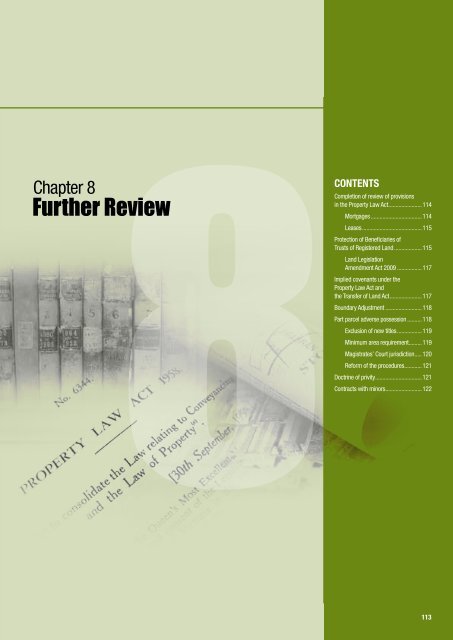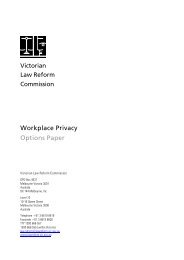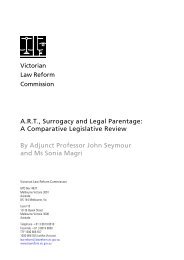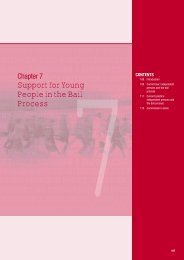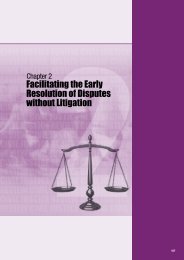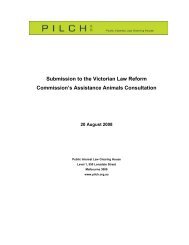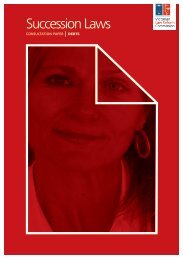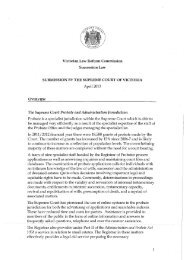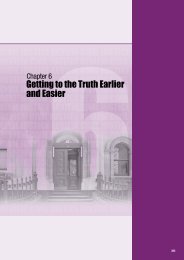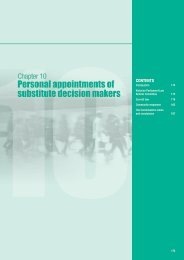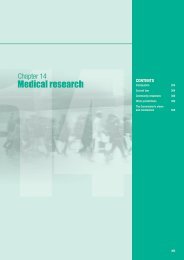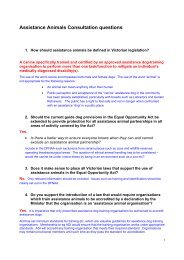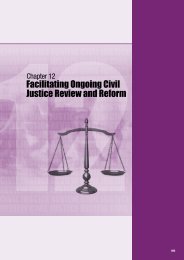Further Review - Victorian Law Reform Commission
Further Review - Victorian Law Reform Commission
Further Review - Victorian Law Reform Commission
Create successful ePaper yourself
Turn your PDF publications into a flip-book with our unique Google optimized e-Paper software.
Chapter 8<strong>Further</strong> <strong>Review</strong>8CONTENTSCompletion of review of provisionsin the Property <strong>Law</strong> Act.......................114Mortgages....................................114Leases..........................................115Protection of Beneficiaries ofTrusts of Registered Land....................115Land LegislationAmendment Act 2009..................117Implied covenants under theProperty <strong>Law</strong> Act andthe Transfer of Land Act......................117Boundary Adjustment..........................118Part parcel adverse possession...........118Exclusion of new titles..................119Minimum area requirement.........119Magistrates’ Court jurisdiction.....120<strong>Reform</strong> of the procedures............121Doctrine of privity................................121Contracts with minors.........................122113113
Chapter 8<strong>Further</strong> <strong>Review</strong>8.19 The Torrens System is premised on the idea that purchasers should be able to dealwith the trustees as if they are absolute owners, and not be concerned to enquirewhether the trustees are acting in breach of trust. 14 Section 43 of the Transfer ofLand Act provides that the purchaser is not affected by notice of a trust or equitableinterest. Only the fraud of the purchaser or the purchaser’s agent will prevent apurchaser obtaining registered title free of any prior beneficial interest. 15 Beneficiarieswho suffer loss will have no claim under the compensation provisions. 168.20 Although trusts are to be kept off the register and behind a ‘curtain’, 17 it was neverintended that beneficiaries would be left unprotected. The Transfer of Land Act and itspredecessors contained a set of provisions which empowered the Registrar to preventthe registration of dealings by trustees acting in breach of trust. Section 37 of the 1958Act provided that a copy of the trust deed could be deposited with the Registrar, andthe Registrar was empowered ‘to protect in any way he deems advisable the rights ofpersons for the time being beneficially interested thereunder’. 188.21 The Registrar was also empowered by section 106(a) of the Transfer of Land Act tolodge a Queen’s caveat on behalf of any minor, person of unsound mind or personabsent from Victoria, to prevent any dealing with land belonging to the person or toprevent any fraud or improper dealing.8.22 It was for many years the practice for legal examiners in the Registry to examinedealings by trustees and to refuse to register any that were found to be in breach oftrust. In Templeton v The Leviathan Pty Ltd 19 the High Court of Australia unanimouslyheld that the Registrar for Victoria was ‘thoroughly justified’ 20 in refusing to registera second mortgage by trustees that was in breach of trust. Knox CJ said that it wasthe duty of the Registrar not to register a dealing which, to the knowledge of theRegistrar, was in breach of trust or in any way improper. 218.23 Notwithstanding the benefits of Registry examination as exemplified in Templeton vThe Leviathan Pty Ltd, leading academic commentators Douglas Whalan andRobert Stein have argued that trust beneficiaries are inadequately protected againstbeing overrreached by improper dealings by the trustees. 22 In 1974 the Queensland<strong>Law</strong> <strong>Reform</strong> <strong>Commission</strong> noted the limitations of the legislative machinery forprotection of trust beneficiaries, while commending the practice of the QueenslandTitles Office in having a senior examiner scrutinise trustee dealings when the officeis in possession of the trust deed. 238.24 The Torrens System depends on vigilance by the Registrar rather than inquiries bypurchasers to protect trust beneficiaries. In some cases, the impropriety of a dealingwill be apparent to an examiner without the need to refer to a trust deed. 24 In othercases, the impropriety will be apparent only when the dealing is scrutinised againstthe terms of the trust deed.116<strong>Victorian</strong> <strong>Law</strong> <strong>Reform</strong> <strong>Commission</strong> - <strong>Review</strong> of the Property <strong>Law</strong> Act 1958: Final Report
LanD LEGisLation amenDment ACT 20098.25 Registry examiners no longer have access to trust deeds when scrutinising dealingsby trustees. Section 22(2) of the Land Legislation Amendment Act 2009, which cameinto operation in May 2010, provided that a trust deed may not be deposited withthe Registrar.8.26 The 2009 legislation also amended section 106(a) to alter the nature of the interestin land that can be protected by a Queen’s caveat lodged on behalf of a minor orperson of unsound mind. The amendment provides that the caveat may be lodgedin respect of land registered in the name of 25 such a person. The previous wordingreferred more generally to land ‘belonging or supposed to belong to such a person’.8.27 In our Consultation Paper, we said that the amendments had further weakened theprotections for beneficiaries of trusts, particularly minors and persons of unsoundmind. Beneficiaries can lodge a caveat against dealings under section 89 of theTransfer of Land Act, but this requires that they are aware of their interest and havethe capacity to lodge a caveat. Whalan comments that: 26[N]one of the present methods of protecting trusts of Torrens system land isadequate to give full protection to beneficiaries; for instance, it must be arare beneficiary indeed, who is a minor, who knows of the existence of thecaveat system.8.28 The caveat system also provides inadequate protection for a beneficiary under adiscretionary trust, who ‘does not have an interest in the land owned by the trustsufficient to found a caveat’. 278.29 Land Victoria submitted that the 2009 amendments to section 37 are not significantas any trust deeds which are lodged are ‘rarely cross-referenced to folios in theRegister’. 28 In their view, the amendment has ‘removed any “false comfort” a partymay feel by depositing a trust deed with the Registrar’. 298.30 In light of this discussion and the relationship of this issue with our reformrecommendations in Chapter 5, we consider that there should be a further review ofthe protection afforded to beneficiaries of trusts of land under the operation of theTransfer of Land Act.IMPLieD COVenants UNDER THE PROPERTY <strong>Law</strong> ACT anD THETRansfeR of LanD ACT8.31 Following our discussion in Chapter 3 about implied covenants, the application ofimplied covenants for title under the Property <strong>Law</strong> Act to registered land requiresclarification. We see a need for review of the consistency in the content of allcovenants implied in instruments relating to transactions in old system land, and inboth registered and unregistered dealings in registered land.8.32 This review could be undertaken as part of the second stage of the <strong>Commission</strong>’sreview of Victoria’s property laws, which is to encompass aspects of theTransfer of Land Act.14 Douglas Whalan, The Torrens System inAustralia (<strong>Law</strong>book Co, 1982) 210–11.15 Transfer of Land Act 1958 (Vic) ss 42 43.16 Transfer of Land Act 1958 (Vic)s 109(2)(a).17 Transfer of Land Act 1958 (Vic) s 37provides that the Registrar shall not recordtrusts in the Register. Ruoff called this ‘thecurtain principle’: Theodore Ruoff, AnEnglishman looks at the Torrens System(1957) 11.18 The Land Legislation Amendment Act2009 (Vic) s 22(2) inserted s 37(2), whichprovides that from the commencementof that Act, a trust may not be depositedwith the Registrar.19 (1921) 30 CLR 34.20 Templeton v The Leviathan Pty Ltd (1921)30 CLR 34, 75 Starke J.21 Templeton v The Leviathan Pty Ltd (1921)30 CLR 34, 53.22 Douglas Whalan, ‘Partial Restorationof the integrity of the Torrens SystemRegister: Notation of Trusts and LandUse Planning and Control’ (1970) 4New Zealand Universities <strong>Law</strong> <strong>Review</strong> 1;Robert Stein, ‘Torrens Title: A Case forthe Registration of Trusts in New SouthWales’ (1980–82) 9 Sydney <strong>Law</strong> <strong>Review</strong>605.23 Queensland <strong>Law</strong> <strong>Reform</strong> <strong>Commission</strong>,Working Paper of the Queensland <strong>Law</strong><strong>Reform</strong> <strong>Commission</strong> on a Bill in Respectof an Act to <strong>Reform</strong> and Consolidate theReal Property Acts of Queensland WP 32(1989) 158.24 This was the case in Templeton v TheLeviathan Pty Ltd, where the trusteeswere purporting to grant a secondmortgage which was also a contributorymortgage.25 Inserted by Land Legislation AmendmentAct 2009 (Vic) s 59(1), emphasis added.26 Land Victoria, Submission 18, 4–5.27 Walter v Registrar of Titles [2003] VSCA122, [15]; R & I Bank of Western Australiav Anchorage Investments Pty Ltd (1992)10 WAR 59 (WASC Full Crt).28 Land Victoria, Submission 18, 4–5.29 Land Victoria, Submission 18, 5.117
Chapter 8<strong>Further</strong> <strong>Review</strong>BOUNDARY ADJUstment8.33 In Chapter 4 we noted that submissions had raised a problem with shortages inmeasurement in Crown surveys and private subdivisions. We explained that therewas a need to expressly authorise the Registrar to distribute shortages among lotsin a subdivision and amend the recordings in the folios accordingly. The power todistribute shortages and make amendments should be exercised in accordance withguidelines issued by the Minister in consultation with the Surveyor-General.8.34 Any deprivation of property rights to an area of land resulting from amendment ofthe land description to distribute a shortage raises an issue of compensation, whichshould be examined as part of a review of the Transfer of Land Act.PART PARCEL ADVERse Possession8.35 The rule of part parcel adverse possession is explained in Chapter 4. 308.36 Although the rule of adverse possession can be used to acquire titles to whole lots aswell as parts of lots, whole parcel adverse possession is generally directed to solving adifferent problem.8.37 Most Australian jurisdictions and New Zealand allow whole parcel adverse possessionin order to update the register in cases of missing owners. The problem often ariseswhen land is sold or inherited but no dealing is lodged with the Registrar. Theregistered title may remain in the name of the seller or deceased former owner aftersomeone else has taken possession as owner. Once a lot has been sold off-register,subsequent sales are also likely to be off-register, as owners buy and sell possessorytitles using deeds of conveyance. Allowing the owner in possession to upgrade theirpossessory title to registered title ‘aligns possession to proprietorship and regularisesthe register’. 318.38 Part parcel adverse possession is used to resolve problems resulting from mistakesabout the location of boundaries and the placement of improvements. 32 As thesubmission from the Surveying and Spatial Sciences Institute said: 33The reality is that occupation seldom accords with title dimensions andit is essential to have a mechanism to deal with boundary repair issues.8.39 The adverse possession rule also tends to reduce conveyancing costs. It enablespurchasers to some extent to assume that they will acquire title to the land asphysically enclosed and occupied, provided that fences and other physical boundarieshave been in place for the limitation period. 34 The expectation that ‘what you see iswhat you get’ enables purchasers and their mortgagees in most cases to dispensewith a re-survey, 35 thereby saving around $900–$1000 36 and avoiding the disputesbetween vendors and purchasers which a re-survey would tend to stir up if it revealsboundary discrepancies. 378.40 In Chapter 4, we noted that several jurisdictions either do not allow part parcel adversepossession at all, allow it only subject to a right of veto by the registered owner ofthe subject land, or impose restrictions as to the size of the area that can be claimed.Victoria imposes restrictions as to the ownership by excluding land owned by certainpublic authorities from the operation of the rule. 38 Based on the different approaches,we identified several options for the relationship between the proposed buildingencroachment relief provision and adverse possession.8.41 As we noted in Chapter 4, most submissions supported the retention of the adversepossession rule. Accordingly we make no recommendation for modification of therule for the purposes of introduction of the building encroachment relief provision.118<strong>Victorian</strong> <strong>Law</strong> <strong>Reform</strong> <strong>Commission</strong> - <strong>Review</strong> of the Property <strong>Law</strong> Act 1958: Final Report
8.42 The submissions raised various issues and reform proposals relating to the operationof the rule, which could be the subject of a further review. The proposals relate to:• the possible exclusion of the rule in relation to newly issued titles• the introduction of a minimum area for claims• the vesting of jurisdiction in the Magistrates’ Court to hear disputed claims• prevention of deliberate encroachment and enclosing of portions ofadjacent land• reform of procedures to comply with human rights norms.EXCLUsion of new titLes8.43 In the submissions, the most commonly cited reason for retention of part parceladverse possession was to resolve boundary errors and discrepancies arising fromdeficiencies in early Crown surveys and past subdivisions. Several submissions pointedout that surveying is now highly accurate, and newly created lots are unlikely to sufferthe defects of the past. The Association of Consulting Surveyors submitted: 39Considering that the current reliability of boundary definition ... is high andcurrent building construction methodologies and practices generally requiresurvey definition of boundaries prior to construction, the Association believesit would be appropriate to consider removal of some adverse possession inrelation to newly issued titles.8.44 This amounts to a proposal for phasing out part parcel adverse possession bydisapplying it to lots created after a specified date.MINIMUM ARea REQUIRement8.45 The Surveying and Spatial Sciences Institute, while supporting the retention of therule of adverse possession, saw a need to exclude claims to very small portions ofland. They cited an example of a claim to a 50–80 mm strip of land along a side fencewhich abutted a number of other lots and required amendment of multiple titles. 408.46 Their submission also anticipates a spate of claims to small slivers of land resultingfrom Clause 54.04 of the <strong>Victorian</strong> Planning Principles, which provides that buildingsconstructed within 150mm of a boundary are accepted as ‘practically’ on theboundary for town planning purposes. The submission states: 41The legacy of this will be to create a further number of small strips whichunder the Statute of Limitations Act fifteen years later, can provide commonlaw possessory rights to the adjoining owner of a small strip of land which isunviable to register, causing further inconsistencies to the State Cadastre.8.47 The Institute suggests that consideration be given to excluding adverse possessionclaims to strips of land not exceeding 150 mm, perhaps by amending section 272 ofthe Property <strong>Law</strong> Act. 428.48 Section 272 of the Property <strong>Law</strong> Act provides for a margin of error in the descriptionof boundaries. Under section 272 the boundaries of any parcel of land, as stated inany document of title or on any plan, are construed as though the phrase ‘a littlemore or less’ immediately followed the dimensions. The phrase itself is deemed tocover any discrepancy that does not exceed 50 millimetres where the boundary lineis less than 40.30 metres and 1/500 of the boundary line where it exceeds 40.30metres. Section 272 further provides that:No action shall be brought by reason or in respect of such difference (whetherexcess or deficit) where it does not exceed the aforesaid limits.30 See [4.47]–[4.50].31 Land Victoria, Submission 18, 4.32 See [4.47]–[4.50] in Chapter 4.33 Surveying and Spatial Sciences Institute,Submission 11, 2.34 Malcolm Park and Ian Williamson,‘The Need to Provide for BoundaryAdjustments in a Registered Title LandSystem’ (2003) 48 Australian Surveyor 5050–51.35 In NSW, where there is no part parceladverse possession, surveys are routinelyconducted prior to the sale of land, oftenat the requirement of the mortgagee.36 Lindsay Perry, a consulting surveyor,estimates the average cost of a reestablishmentsurvey at $800–$900 plusGST: oral communication, 14 July 2010.37 Under the standard form contract of sale,an omission or mistake in the description,measurements or area of the land doesnot invalidate the sale, and the purchaseris not entitled to make any objection orclaim for compensation for any allegedmisdescription or deficiency in area ormeasurements: Estate Agents (Contracts)Regulations 2008 (Vic), Form 2, Clauses3.1, 3.2.38 Limitation of Actions Act 1958 (Vic) ss 7,7A, 7AB, 7B.39 Association of Consulting Surveyors,Submission 15, 4.40 Surveying and Spatial Sciences Institute,Submission 11, 2.41 Surveying and Spatial Sciences Institute,Submission 11, 2.42 Surveying and Spatial Sciences Institute,Submission 11, 1–2.119
Chapter 8<strong>Further</strong> <strong>Review</strong>8.49 The section was judicially interpreted in PCH Melbourne Pty Ltd v Break FastInvestments. 43 Smith J held that section 272 would not provide a defence to a claimin trespass by building encroachment. In particular Smith J held that section 272introduces a margin of error for the dimensions appearing on title documents, butdoes not introduce a margin of error as to the actual title boundary ’as found byadmeasurement on the ground’. 448.50 It would therefore appear that the legal effect of section 272 is to limit claims relatedto small boundary discrepancies in sales of land, 45 but not to limit claims of adversepossession and trespass arising from boundary discrepancies. 468.51 Therefore, any minimum area requirement for adverse possession claims would be anew provision and not an amendment to section 272.MAGistRates’ COURT JURisDICtion8.52 A person who claims to have acquired title to the whole or part of a registered lotby adverse possession may apply to the Registrar under section 60 of the Transfer ofLand Act for an order vesting in him or her a registered title to the relevant land. If aperson lodges a caveat under section 61, the Registrar must not make a vesting orderuntil the caveat has been withdrawn or has lapsed or a judgment or order is obtainedfrom a court. 478.53 The <strong>Law</strong> Institute of Victoria said in its submission that, while it supports the retentionof part parcel adverse possession, ‘such disputes are very expensive to resolve in theSupreme Court of Victoria’. 48 It proposes that a Court similar to the New South WalesLand and Environment Court be established, or alternatively that a specialist divisionof the Magistrates’ Court with expertise in property law be established and givenjurisdiction to determine disputes where the land in question is adjacent to a propertyboundary and does not exceed 30 square metres.8.54 Recent amendments to the Transfer of Land Act appear to have given theMagistrates’ Court jurisdiction to hear and determine matters under that Actconcurrently with the Supreme and County Courts, 49 but it is unclear what thescope of the jurisdiction conferred on the Magistrates’ Court is. The amendeddefinition now provides that ‘”a court” means a court of competent jurisdiction’.On one view, the amendment, read in conjunction with various provisions in theTransfer of Land Act which confer jurisdiction on ‘a court’, gives the Magistrates’Court unlimited jurisdiction in statutory causes of action. 50 On a narrower reading,the Court is given jurisdiction only in matters to which its jurisdictional limit canapply, 51 such as an action against the Registrar for damages under section 110of the Transfer of Land Act.8.55 We consider that the Court’s jurisdiction in adverse possession matters under theTransfer of Land Act should be defined consistently with its jurisdiction under thebuilding encroachment relief provision. 528.56 The question of whether a Land and Environment Court or a specialist propertylaw division of the Magistrates’ Court should be established warrants furtherconsideration.120<strong>Victorian</strong> <strong>Law</strong> <strong>Reform</strong> <strong>Commission</strong> - <strong>Review</strong> of the Property <strong>Law</strong> Act 1958: Final Report
RefoRM of THE PROCEDURes8.57 If part parcel adverse possession is retained, we suggest that it be reviewed to addresstwo major problems with the current law in Victoria. 538.58 The first is the need for additional measures to control the incentives that therule creates for deliberate encroachment. 54 Mr Leitch submits that prevention ofencroachment and building overlaps should be considered. 558.59 The second is the lack of due process for landowners before extinguishmentof their title. A rule under which a landowner’s property right is automaticallyextinguished by operation of statute without notice or hearing process is arguablyinconsistent with the protection of landowner’s human right not to be arbitrarilydeprived of their property. 568.60 Other jurisdictions, such as England, have taken steps to address these problems byadjusting their provisions for part parcel adverse possession. 57DOCTRine of PRIVitY8.61 In discussing section 56 in our Consultation Paper, we noted that it was onceinterpreted as modifying the doctrine of privity but has since been found to servea much narrower purpose. We briefly discussed reforms to the doctrine in otherjurisdictions and concluded that any need for change in Victoria requires separateexamination and possibly comprehensive legislation setting out the circumstancesin which a third party can enforce a contractual term and the remedies availablefor a breach.8.62 The comments we received on section 56 indicate that the operation of the doctrineof privity is a live issue and one on which there is no consensus. 58 The Queensland <strong>Law</strong><strong>Reform</strong> <strong>Commission</strong> examined in detail the effect of the doctrine in its 1973 report onproperty law. 59 It observed that: 60[T]here is little doubt that in general the rule is highly inconvenient andthat it defeats the reasonable and justifiable expectations of the parties,enabling persons to escape from obligations which they have, often for value,deliberately undertaken.8.63 While conceding that the doctrine occasionally appears to produce a beneficial orjust result, the Queensland <strong>Law</strong> <strong>Reform</strong> <strong>Commission</strong> concluded that it is a source ofserious injustice: 61[h]ence, a promise given for consideration to discharge the debt of another isunenforceable by the latter … as is a promise by a man to pay his future son-inlawa sum of money given in consideration of a like promise by another person:… to a husband to pay his widow an annuity after his death … ; or by a partnerto pay an annuity to his partner’s daughter: … ; a promise by an insurer to paypolicy moneys to a relative of the insured … ; and a promise by a father to amother to pay weekly maintenance to his epileptic son. [references omitted]8.64 The retention of the doctrine of privity in Australia is out of step with other legalsystems and increasingly differs from other common law jurisdictions. The Queensland<strong>Law</strong> <strong>Reform</strong> <strong>Commission</strong> observed in 1973 that France, Germany and South Africahave no such rule, and nor do the common law jurisdictions of the United States. 62More recently, New Zealand and England have significantly modified the doctrine.8.65 <strong>Reform</strong> in Australia has been piecemeal and less extensive. Western Australia,Queensland and the Northern Territory have enacted property legislation thatabrogates the doctrine of privity of contract but the other jurisdictions have notpassed legislation that extends the rights of third party beneficiaries generally.43 [2007] VSC 87.44 PCH Melbourne Pty Ltd v Break Fast[2007] VSC 87 [31].45 See Robinson (1992), above n 5, 504,citing Monaghan v Gleeson (1887) 13VLR 384.46 The Surveying and Spatial SciencesInstitute put forward the position that itdoes prevent such claims; Submission 11,1.47 Transfer of Land Act 1958 (Vic) ss 61,26R(3).48 <strong>Law</strong> Institute of Victoria, Submission 13,15.49 See definition of ‘court’ inserted into s4(1) of the Transfer of Land Act by s 3of the Land <strong>Law</strong> Legislation AmendmentAct (Vic) 2009, which commenced 1 May2010.50 See Magistrates’ Court Act 1989 (Vic)s 100(d).51 The civil jurisdictional limit of the Courtapplies only in actions for debt, damagesand liquidated demands and in claimsfor equitable relief, but not in statutorycauses of action vested in the Court byother Acts: Magistrates Court Act 1989(Vic) s 100(1).52 See Chapter 4.53 Associate Professor Maureen Tehan et al,Submission 9.54 See eg, Monash City Council v Melville[2000] VSC 55 where landownersacquired title to a 20 foot strip of councilreserve land which they had enclosedwith their own land with the intention (asEames J inferred at [30]) of acquiring titleby adverse possession.55 Mr Peter Leitch, Submission 10.56 Brendan Edgeworth, ‘Adverse Possession,Prescription and their <strong>Reform</strong> in Australian<strong>Law</strong>’ (2007) 15 Australian Property <strong>Law</strong>Journal 1. United Nations Declarationon Human Rights, art 17(2) provides‘No one shall be arbitrarily deprived oftheir property’. See also the Charter ofHuman Rights and Responsibilities Act2006 (Vic) s 20. Victoria’s provisions aresimilar to the provisions of the (repealed)Land Registration Act 1925 (UK) whichwere challenged in J A Pye (Oxford) LandLtd v the United Kingdom [2005] ECHR44302/02. The Court held by a majoritythat the English provisions breachedArticle 1 of Protocol 1 of the EuropeanCharter of Human Rights. On appeal,the Grand Chamber held by a vote of10 to 7 that the provisions did not breachArticle 1.57 See eg, Pamela O’Connor, ‘The PrivateTaking of Land: Adverse Possession,Encroachment by Buildings andImprovement Under a Mistake’ (2006)33 (1) The University of Western Australia<strong>Law</strong> <strong>Review</strong> 31 44.58 Mr Michael Macnamara, Submission2; Mr James Hope and Dr Paul Vout,Submission 6; Associate ProfessorMaureen Tehan et al, Submission 9; <strong>Law</strong>Institute of Victoria, Submission 13.59 Queensland <strong>Law</strong> <strong>Reform</strong> <strong>Commission</strong>(1973), above n 10, 37–41.60 Ibid 38.61 Ibid.62 Ibid 37.121
Chapter 8<strong>Further</strong> <strong>Review</strong>8.66 The fact that other Australian jurisdictionshave not introduced similar reforms does notnecessarily mean that they should. Mr Hopeand Dr Vout pointed out in their submissionthat, despite the occasional harsh outcome,privity gives a degree of economic and legalcertainty and that ‘restriction (or, at theextreme end, removal) of privity of contractwould almost undoubtedly result in increasedlitigation’. 638.67 We remain of the view that this issue requiresseparate review.ContRACts witH minoRS8.68 When consulting with consumer affairsexperts about section 28B, concerningcontracts with minors, our attentionwas drawn to the fact that the generalprovisions in the Supreme Court Act 1986that determine the validity of contracts withminors are substantially unchanged sincethe 19th century.8.69 The law in Victoria, which generally makesminors’ contracts void, has not kept pacewith developments in other jurisdictions inAustralia. Those that had similar provisionshave since replaced them with legislationwhich takes greater account of the maturity ofthe minor.8.70 The <strong>Victorian</strong> law was reviewed in 1970 bythe Chief Justice’s <strong>Law</strong> <strong>Reform</strong> Committee 64but the recommendations were notimplemented.8.71 There may be scope for reform in this area.63 Mr James Hope and Dr Paul Vout,Submission 6, 4.64 Chief Justice’s <strong>Law</strong> <strong>Reform</strong> CommitteeReport Infancy in Relation to Contractsand Property, Report No 3 (1970).122<strong>Victorian</strong> <strong>Law</strong> <strong>Reform</strong> <strong>Commission</strong> - <strong>Review</strong> of the Property <strong>Law</strong> Act 1958: Final Report


